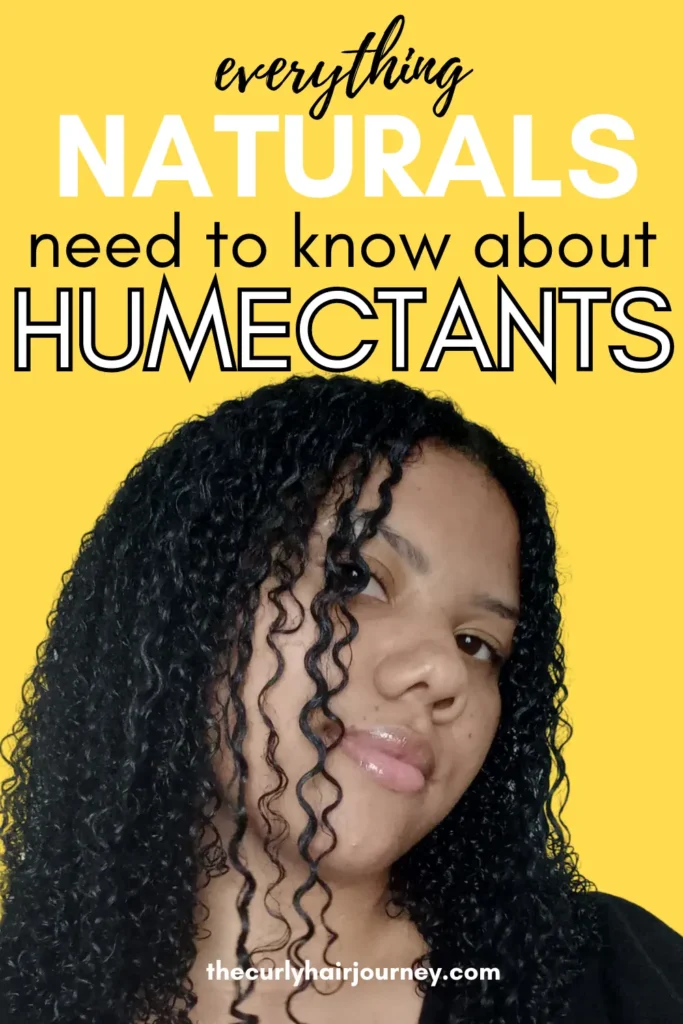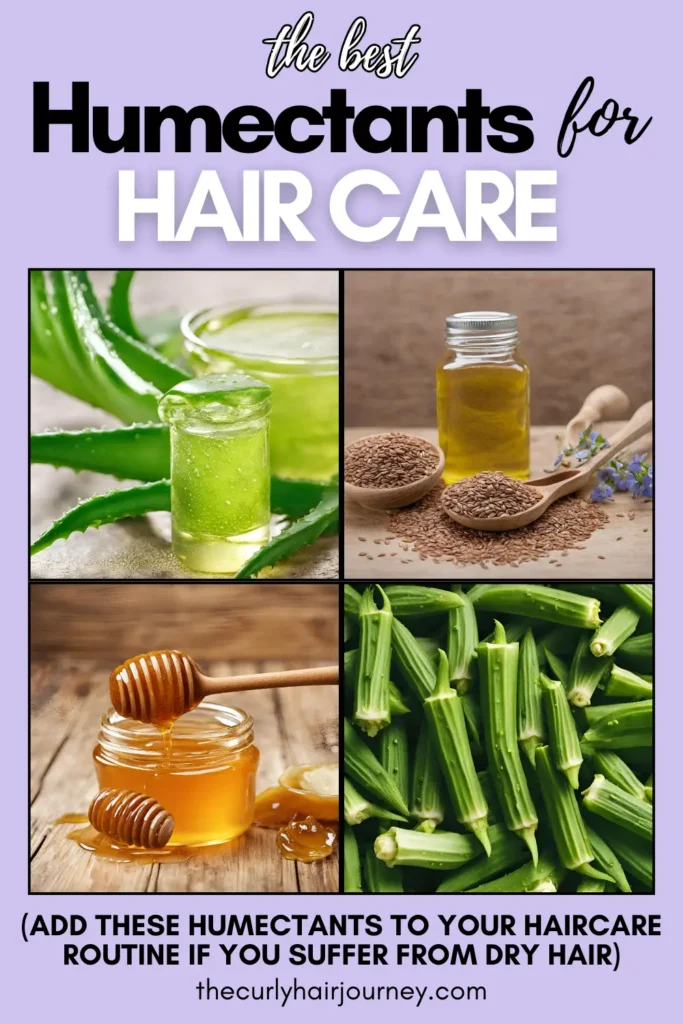Natural Humectants Every Curly Girl Needs For Dry Hair

Are you curious about incorporating humectants into your hair care routine?
Maybe you’re intrigued about the role of humectants and their impact on giving you more healthy hair!
Humectants serve as remarkable components in hair products, catering to the needs of natural hair textures by nourishing, moisturizing, and shielding the hair shaft.
They facilitate maintaining hair softness acting as a natural moisturizer, enhancing curl definition, and combating frizz. I bet this piques your interest, doesn’t it?
In this blog post on humectants for hair, we’ll go into the essence of natural humectants, their mechanisms, and their significance for various natural hair types.
Additionally, we’ll advise you on when staying away from common humectants is preferable and suggest suitable alternatives.
It’s worth mentioning that I love incorporating humectants like hyaluronic acid and glycerin into my hair care routine (even in my skin care products), especially when my hair feels dry or after removing a protective style.
Related Post: 23 Tips On How To Grow Black Natural Hair Fast & Longer
What Are Natural Hemectants?
Humectants (natural humectants and synthetic humectants) act as water magnets, drawing moisture from the surrounding environment into your hair shaft.
This is particularly crucial for dry hair and curly hair types, as natural oils often struggle to travel down the hair shaft properly, leaving it susceptible to dryness, brittleness, and hair breakage.
Unlike occlusive ingredients, such as petroleum jelly and waxes, which create a barrier to prevent much moisture loss, and emollients, like butters (shea butter and mango butter) and oils, which soften and nourish hair while sealing in moisture, humectants play a different role.
They are hydrophilic ingredients found in hair care products, specifically formulated to moisturize and repair damaged hair.
So as I mentioned before, humectants attract water molecules, pulling moisture from the air or the products applied to your hair.
Once attracted, they bind this moisture to the hair shaft, effectively increasing hair moisture levels and reducing the risk of damage.
This process is essential for maintaining healthy hair, especially in low humidity environments where moisture loss is more prevalent.
In essence, humectants serve as a vital component in your hair care routine, acting as natural moisturizers that replenish and retain moisture levels, ultimately contributing to the overall health and appearance of your hair.
Related Post: How To Moisturize Your Natural Hair – The LCO vs LOC Method
How Do Humectants Work For Hair Care?
When applied correctly, these water magnets not only hydrate your hair strands but also enhance its elasticity, and protect it from dryness and damage.
But how exactly does this work?
To understand this, we have to talk about adsorption—a process distinct from absorption, where atoms and molecules cling to a surface rather than dissolve within it.
Through hydrogen bonds, humectants like hyaluronic acid create weak yet intense connections with water molecules, made stronger by the polarity of atoms.
Imagine water molecules as tiny magnets, each with a positively charged hydrogen end and a negatively charged oxygen end.
These oppositely charged ends attract, forming hydrogen bonds that weave a web of moisture.
Humectants, with their polar hydroxyl groups, eagerly join this dance, bonding with water molecules and securing them to the hair shaft.
But not all humectants are created equal.
Their efficacy hinges on the abundance of water-loving sites they possess.
Take hyaluronic acid, for instance—an unrivaled powerhouse capable of binding an astonishing 1000 times its weight in water.
Humectants act as guardians of hydration, strengthening the hair against the ravages of dryness and promoting its health and strength.
So, next time you reach for a hair product enriched with humectants, rest assured you’re wielding the magic of moisture to increase your hair’s moisture levels.
Related Post: DIY Pre-Poo for Low Porosity Hair Recipes For Hydration
Why We Need Humectants In Hair Care

Your scalp naturally secretes sebum, a waxy substance that forms a protective shield.
Ideally, these natural oils should envelop every hair strand from root to tip, protecting the hair shaft against dryness and brittleness.
However, if you have wavy, coily, or curly hair, the twists and turns stop the downward flow of sebum.
Consequently, your hair remains deprived of its protective coating, making it susceptible to frizz, knots, and breakage.
Here’s where humectants come into play.
Infusing hydration into your hair, making it supple, voluminous, and less prone to hair breakage. And, they enhance curl definition and protect your hair against heat damage and chemical treatments.
Related Post: Do You Need To Oil Your Scalp?
When To Use Humectants
Considering the weather conditions, particularly the dew point, and humidity, is important when contemplating the use of humectants on curly hair.
The dew point, indicating the saturation of air with moisture, varies with temperature. A lower dew point signifies drier air compared to a higher dew point.
Humectants, often found in conditioners, leave-ins, and styling products, play a vital role in hair care routines. However, it’s important to be mindful of the dew point’s influence.
Optimal conditions for using humectant-rich products typically arise when the dew point ranges from 35°F to 50°F, so a low dew point.
During this period, humectants excel in drawing moisture into the hair shaft.
Yet, I always advise you to complement humectants with emollients, aiding in moisture retention within the hair strands.
Related Post: An Easy Guide For A Natural Hair Wash Day Routine
When Not To Use Humectants
In high humidity conditions, excessive moisture absorption by humectants can lead to unwelcome consequences for your hair shaft.
The influx of so much water causes the hair strands to swell uncontrollably, disrupting the hair cuticles and potentially causing longitudinal cracking.
This phenomenon results in loss of hair shape, manifesting as unruly frizz, a predicament exacerbated for those with high-porosity hair.
Conversely, in environments characterized by low humidity, humectants may extract moisture from the hair shaft, rendering it dry and fragile.
Therefore, extreme ends of the humidity spectrum warrant caution when using humectants.
In such scenarios, it’s important to balance their usage with anti-humectants or humidity-resistant ingredients.
For dew points exceeding 50°F or dipping below 35°F, opt for products strengthened with anti-humectants, such as emollients, and humidity-resistant agents like poly quats or silicones.
This proactive approach shields your hair, preserving its integrity and overall appearance.
This precaution holds particular significance for individuals with coily or curly hair, prone to dryness and susceptibility to damage.
Related Post: The Best Wash & Go Hair Products For Natural Hair
The Best Humectant To Add To Your Hair Care

Humectants featured in hair care products can come from either synthetic or natural sources.
Additionally, there are biologically produced humectants, often boasting complex names yet derived from natural ingredients.
Natural Humectants:
- Glycerin (including vegetable glycerin)
- Aloe vera gel
- Honey
- Pure avocado oil
- Lecithin
- Panthenol (Pro Vitamin B5)
Biological Origin Humectants:
- Agave Nectar
- Glucose
- Fructose
- Glycogen
- Glycolic acid
- Hyaluronic Acid
- Hydrolyzed Proteins (Hydrolyzed silk protein)
- Inositol
- Isoceteth-x
- Silicon Polyols
- Sodium PCA
- Sorbitol
- Steareth-x
- Sugars and Modified Sugars
- Xylitol
Synthetic Humectants:
- Propylene Glycol
- Ethylene/Diethylene Glycol
- PEG Compounds (For example, polyethylene glycol)
It’s noteworthy that synthetic humectants may provoke irritation and contact dermatitis, particularly for individuals with sensitive skin.
Therefore, exercising caution and avoiding these ingredients is advisable if you have sensitive skin or are prone to adverse reactions.
Related Post:
Choosing The Right Humectants For Hair
Now that you know about humectants, I bet you want a piece of the pie. I know navigating the many humectants available can leave you feeling a little lost.
Among the strong contenders are potent humectants like glycerin, sodium lactate, or sodium PCA, known for their remarkable ability to draw in high levels of hydration.
However, in certain weather conditions, such as extreme dryness or humidity, opting for milder alternatives like hydrolyzed silk protein or panthenol may prove more beneficial.
Pairing these gentler options with an anti-humectant can provide added protection for your hair shaft.
Moreover, it’s important to scrutinize where the humectant sits on the ingredients list.
As approximately 80% of a hair care product comprises the first five ingredients listed, the placement of the humectant can significantly influence its impact on your hair.
If the humectant ranks lower on the list, it may not be as effective.
So, finding the best humectant for your curly hair involves considering its potency, compatibility with weather conditions, and placement within the product’s ingredient hierarchy.
Related Post:
How To Add Humectants To Your Hair Care Routine
Maintaining a well-rounded hair care routine is important to ensuring your hair remains adequately moisturized, resilient, and healthy.
Incorporating both humectants and anti-humectants into your hair care routine is key to promoting optimal hair health.
Regular use of humectants contributes to enhancing hair shine, reducing frizz, and reducing hair breakage.
Additionally, it aids in replenishing lost nutrients, resulting in softer, more manageable hair.
However, in environments where humidity exceeds 80% or falls below 40%, the inclusion of anti-humectants becomes even more crucial.
These ingredients serve as guardians, preventing your hair from absorbing much moisture or succumbing to dryness and brittleness.
By striking a delicate balance between humectants and anti-humectants, you can effectively safeguard your hair’s moisture levels and overall well-being across varying environmental conditions.
Related Post:
My Humectant Rich Hair Care Routine
I love to incorporate humectants into my hair care routine, as well as occlusive and emollients of course. Here is my routine:
1. Pre-Shampoo Treatment: I begin by applying a pre-shampoo treatment enriched with natural humectants such as honey or glycerin to damp hair, or sometimes I opt for a protein-rich pre-poo treatment like coconut oil.
This helps to pre-condition and prepare my hair for cleansing while attracting moisture to the strands.
2. Shampoo: I wash my hair with a moisturizing shampoo containing humectants like sodium PCA or panthenol.
I gently massage the scalp to remove dirt and buildup while retaining moisture in the hair shaft.
On days when my hair is not too dirty but I needed a refresh, I like to co-wash my hair, Here’s Why You Should Be Co-Washing Your Natural Hair.
3. Conditioning: I follow up with a hydrating conditioner also infused with humectants such as hyaluronic acid or aloe vera gel.
I allow the conditioner to sit for a few minutes to deeply nourish and moisturize the hair strands.
4. Deep Conditioning Treatment: On my wash days, I treat my hair with a deep conditioner treatment formulated with humectants like honey or hydrolyzed proteins.
Cover your hair with a shower cap and apply heat for enhanced penetration and hydration.
5. Leave-In Conditioner: Now I apply a leave-in conditioner containing humectants such as glycerin or sodium PCA to damp hair after washing.
This helps to lock in moisture and provide ongoing hydration throughout the day.
6. Styling Products: I like to choose styling products like gels (here is my favorite hair gel) or creams that incorporate film-forming humectants such as sorbitol or propylene glycol.
These hair products not only help to style your hair but also attract moisture and prevent frizz. If you need hairstyle ideas for when you’re lazy, I have a few great ideas here.
7. Finishing Oil or Serum: I finish my hair care routine by applying a lightweight hair oil or serum containing emollients like coconut oil or argan oil.
This helps to seal in moisture, add shine, and protect the hair from environmental stressors.
Weekly Treatment Mask: Once a week, treat your hair with a hydrating mask enriched with humectants like avocado oil or shea butter.
Leave the mask on for 20-30 minutes before rinsing to replenish moisture and improve hair elasticity.
I don’t always do this hair care routine because my hair doesn’t always need it, and it may seem like humectant overkill but trust me my hair needs it on those really dry spells. Especially during winter.
Pin For Later!








